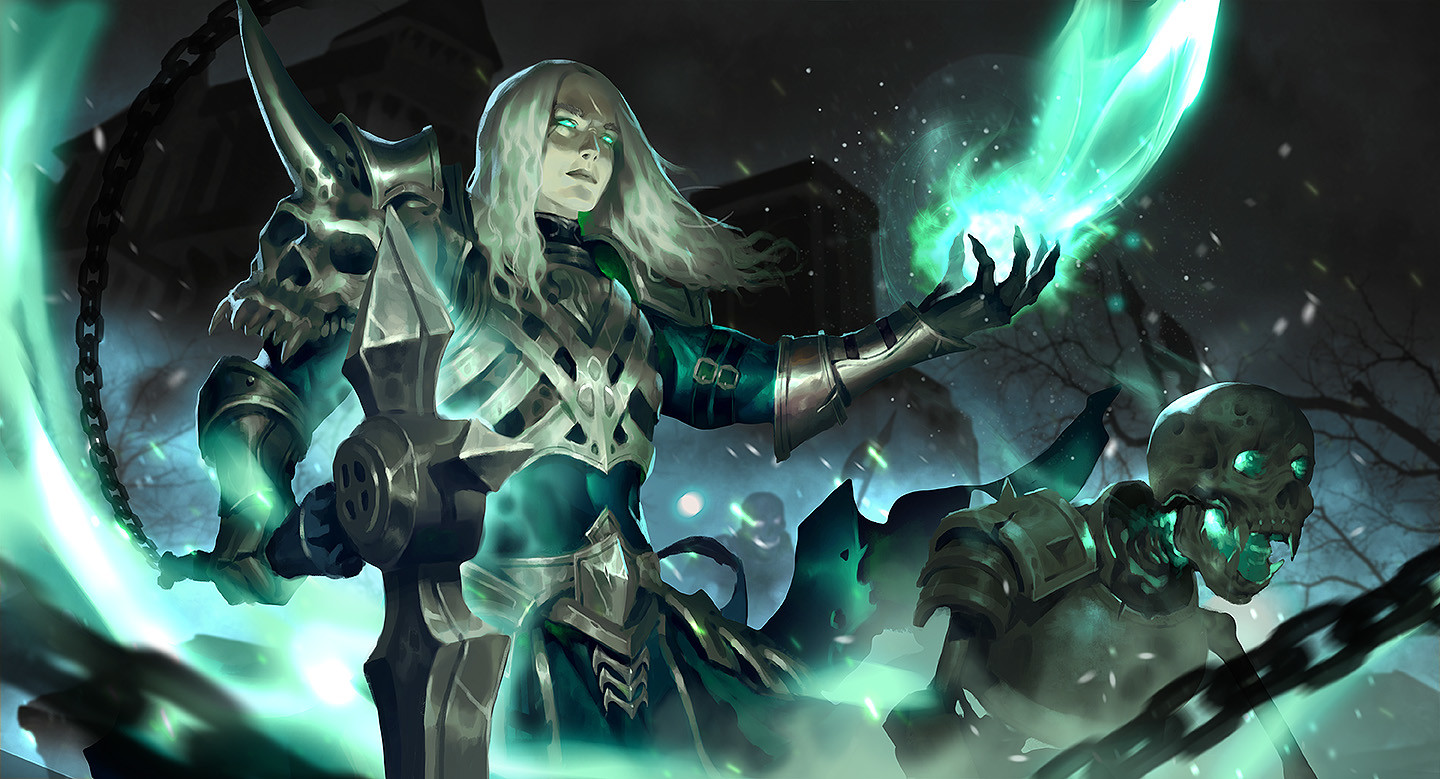Order of the Necromancer
Necromancers explore the cosmic forces of life, death, and undeath. They focus their studies in necromantic magic, as they learn to manipulate the energy that animates all living things. Most people see necromancers as menacing, or even villainous, due to the close association with death. And so does this Order. Not all necromancers are evil, but these Hunters seek to slay them and their creations nonetheless.
Like other Blood Hunter Orders, the Hunters that follow this Order, become what they seek to destroy, a necromancer. Though they are also potent hunters of undead, they mostly focus on eradicating the source of undeath. To do that, they study necromantic magic. Through that, they turn an enemies weapons against them.
Order of the Necromancer Spellcasting table
| Blood Hunter Level | Cantrips Known | 1st | 2nd | 3rd | 4th |
|---|---|---|---|---|---|
| 3rd | 1* + 2 | 2 | - | - | - |
| 4th | 1* + 2 | 3 | - | - | - |
| 5th | 1* + 2 | 3 | - | - | - |
| 6th | 1* + 2 | 3 | - | - | - |
| 7th | 1* + 2 | 4 | 2 | - | - |
| 8th | 1* + 2 | 4 | 2 | - | - |
| 9th | 1* + 2 | 4 | 2 | - | - |
| 10th | 1* + 3 | 4 | 3 | - | - |
| 11th | 1* + 3 | 8 | 4 | 3 | - |
| 12th | 1* + 3 | 8 | 4 | 3 | - |
| 13th | 1* + 3 | 9 | 4 | 3 | 2 |
| 14th | 1* + 3 | 4 | 3 | 2 | - |
| 15th | 1* + 3 | 4 | 3 | 2 | - |
| 16th | 1* + 3 | 4 | 3 | 3 | - |
| 17th | 1* + 3 | 4 | 3 | 3 | - |
| 18th | 1* + 3 | 4 | 3 | 3 | - |
| 19th | 1* + 3 | 4 | 3 | 3 | 1 |
| 20th | 1* + 3 | 4 | 3 | 3 | 1 |
* necromancy cantrip of your choice from any spell list
Image used: Arenanet - 'Guild Wars 2 - Necromancer Wallpaper' (source)
Spellcasting
When you reach 3rd level, your research grants you access to necromantic magic.
Cantrips
You learn one necromancy cantrip of your choice from any spell list, which counts as a wizard cantrip for you, and two cantrips of your choice from the wizard spell list. You learn another wizard cantrip of your choice at 10th level.
Spell Research of 1st Level and Higher
At 3rd level, you have a spellbook containing six 1st-level wizard spells of your choice, three of which must be necromancy spells.
The spells that you add to your spellbook as you gain levels reflect the arcane research you conduct on undead and other monsters you slay on your journey. You might find other spells during your adventures. But most of the times you discover a spell by studying a dead foe and turning their abilities into spells.
For you, all necromancy spells of 1st level and higher, regardless of spell list, count as wizard spells.
Researching a Spell. To add a new spell to your book you must research the spell to learn how to cast it. Researching a spell involves a spell source of some kind. These sources can be corpses of slain creatures, Research in a library and sometimes spellbooks and scrolls. For each level of the spell, the process takes 2 hours and costs 50 gp. The cost represents material components you expend as you
experiment with the spell to master it, as well as the fine inks you need to record it. Once you have spent this time and money, you can prepare the spell just like your other spells.
Replacing the Book. You can copy a spell from your own spellbook into another book-for example, if you want to make a backup copy of your spellbook. This is just like copying a new spell into your spellbook, but faster and easier, since you understand your own notation and already know how to cast the spell. You need spend only 1 hour and 10 gp for each level of the copied spell.
If you lose your spellbook, you can use the same
procedure to transcribe the spells that you have
prepared into a new spellbook.
Filling out the remainder of
your spellbook requires
you to find new spells
to do so, as normal.


Ways of Research. There are 3 main ways to research spells, detailed in the following:
- Dissecting. You can dissect creatures to learn about their kind and abilities, turning their blood into spells. For a necromancy spell, you need an undead creature. For any other spell you usually use monstrosities, abberations, beasts, fiends, dragons or any other non-humanoid creature, befitting the spell and the spell school. Note that these creatures should be recently dead.
- Academic Research. You can conduct research at a library or magical university about a certain type of undead to gain similar spells. To use research as a spell source, you need to spend double the time per level of the spell to add it to the spellbook.
- Spell Copying. You can also copy spells from spellbooks or scrolls in the same way a wizard would. It also takes 2 hours and costs 50 gp to transfer the unique notation into your notation.
The Book's Appearance. Your spellbook is a unique compilation of spells, with its own decorative flourishes and margin notes. It might be a plain, functional leather volume that you received as a gift from your master, a finely bound gilt-edged tome you found in an ancient library or even a loose collection of notes scrounged together after you lost your previous spellbook in a mishap.
Preparing and Casting Spells
The Order of the Necromancer Spellcasting table shows how many spell slots you have to cast your spells of 1st level and higher. To cast one of these spells, you must expend a slot of the spell's level or higher. You regain all expended spell slots when you finish a long rest.
Image used: Jiunn Kuo - 'Diablo - Necromancer' (source)
You prepare the list of spells that are available for you to cast. To do so, choose a number of spells from your spellbook equal to your Intelligence modifier + one third of your Blood Hunter level (minimum of one spell), rounded down. The spells must be of a level for which you have spell slots.
For example, if you know the 1st-level spell Cause Fear and have a 1st-level and a 2nd-level spell slot available, you can cast Cause Fear using either slot.
You can change your list of prepared spells when you finish a long rest. Preparing a new list of wizard spells requires time spent studying your spellbook and memorizing the incantations and gestures you must make to cast the spell: at least 1 minute per spell level for each spell on your list.
Spellcasting Ability
Intelligence is your spellcasting ability for your wizard spells, since you learn your spells through study and memorization. You use your Intelligence whenever a spell refers to your spellcasting ability. In addition, you use your Intelligence modifier when setting the saving throw DC for a wizard spell you cast and when making an attack roll with one.
Spell Save DC
Spell attack modifier
Ritual Casting
You can cast a spell as a ritual if that spell has the ritual tag and you have the spell in your spellbook. You don't need to have the spell prepared.
Spellcasting Focus
You can activate a crimson rite on an arcane focus. You activate it in the same way, that you would do it on a regular weapon. While you have an active Crimson Rite on an arcane focus, you can use the arcane focus as a spellcasting focus (found in chapter 5 of the Player’s Handbook) for your wizard spells.



Image used: Bogdan Marica - 'Necromancer' (source)
Learning Spells of 1st Level and Higher
Every odd level after this you gain in this class, you can add one spell of your choice to your spellbook, which must be a necromancy spell. This spell must be of a level for which you have spell slots, as shown on the Wizard table. On your adventures, you might find other spells that you can add to your spellbook.
Additionally, you can add 2 non-necromancy spells of your choice from the wizard spell list to your spellbook when you reach 8th, 14th, and 20th level.
Potent Bloodcasting
Also at 3rd level, your rites affect your arcane powers. While you have an active Crimson Rite, your cantrips deal additional damage of the active rite's type equal to your hemocraft die. If the cantrip targets multiple creatures, you only deal the additional damage to one.
Necrotic Manipulation
Beginning at 7th level, your spells and Crimson Rites ignore resistance to necrotic damage.
Additionally, when you target an undead creature with a spell, you can suffer damage equal to one roll of your hemocraft die and choose one of the following effects.
- If the spell inflicts a condition, that it would be immune to, you can use your bonus action to ignore the immunity.
- If the spell deals damage and the creature is immune against the type, you can treat the immunity as resistance.
Imbued with Undeath
Beginning at 11th level, you have resistance to necrotic damage, and your hit point maximum can't be reduced. You have spent so much time dealing with undead and the forces that animate them that you have become inured to some of their worst effects.
Brand of the Harvest
Beginning at 15th level, your Brand of Castigation now draws upon your targes life essence. Whenever you damage a branded creature with your Crimson Rite, you regain hit points equal to the damage dealt by your Crimson Rite. You don't gain this benefit for branding constructs.
Blood Curse of Control
Starting at 18th level, you’ve learned to exert your control over undead foes. You gain the Blood Curse of Control for your Blood Maledict feature. This does not count against your number of blood curses known.


New Blood Curse
Blood Curse of Control
Prerequisite: 18th level, Order of the Necromancer
As a bonus action, you can attempt to control an undead creature you can see within 30 feet of you that is no more than one size larger than you. The target must succeed on a Wisdom saving throw or they come under your control until the end of your next turn. They act as if they were created by you and you give them a command as part of the same bonus action
Amplify. This curse affects all undead creatures within range. If they fail their saving throw by 5 or more, they are under your control for an additional turn.
New Necromancy Spells
Due to the lack of necromancy spells overall, I've decided to include links to a few more spells in this document, from other creators. This is to give these Blood hunter some more versatility when it comes to necromancy. Especially, since necromancy cantrips are pretty rare.
Necromancy Spells for the Aspiring Lich by /u/TabaxiTaxidermist